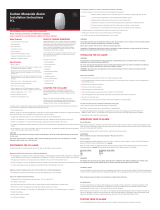
14
The Effects of CO Exposure.
When you breathe carbon monoxide, it enters your bloodstream
through your lungs and attaches to red blood cells. These red
blood cells, called hemoglobin, carry oxygen throughout your
body. Carbon monoxide molecules attach to the red blood cells
200 times faster than oxygen, preventing the flow of oxygen to
your heart, brain and vital organs. As carbon monoxide accumu-
lates in your bloodstream, your body becomes starved for oxy-
gen. The amount of carbon monoxide in a person’s body can be
measured by a simple blood test, called a “carboxyhemoglobin
level” test .
The early symptoms of carbon monoxide poisoning are often
mistaken for the flu – headache, dizziness, weakness, nausea,
vomiting, sleepiness, and confusion.
Could Your Family be at Risk for CO Poisoning?
Carbon monoxide is the number one cause of poisoning deaths
in the United States. According to the Mayo Clinic, at least 10,000
Americans are affected by CO poisoning each year.
While anyone is susceptible, experts agree that unborn babies,
small children, senior citizens and people with heart or respirato-
ry problems are especially vulnerable to CO and are at the great-
est risk for death or serious injury.
Part Two – Carbon Monoxide
• Do not mount the CO alarm directly above or near a diaper
pail.
Note: If you will be staining or stripping wood floors or furniture,
painting, wall-papering, or using aerosols or adhesives for a do-it-
yourself project or hobby, before you begin: Remove the CO
alarm to a remote location to prevent possible damage to or con-
tamination of the sensor. You may wish to unplug the CO alarm
and store it in a plastic bag during the project.
The following is a list of substances which, at high levels, can
affect the sensor and may cause a nuisance alarm that is not a
carbon monoxide alarm.
Methane, propane, iso-butane, ethylene, ethanol, alcohol,
iso-propanol, benzene, toluene, ethyl acetate, hydrogen, hydro-
gen sulfide, sulfur dioxides, most aerosol sprays, alcohol based
products, paints, thinners, solvents, adhesives, hair spray, after
shave, perfume, auto exhaust (cold start) and some cleaning
agents.
Part One – Your Kidde CO Alarm





















